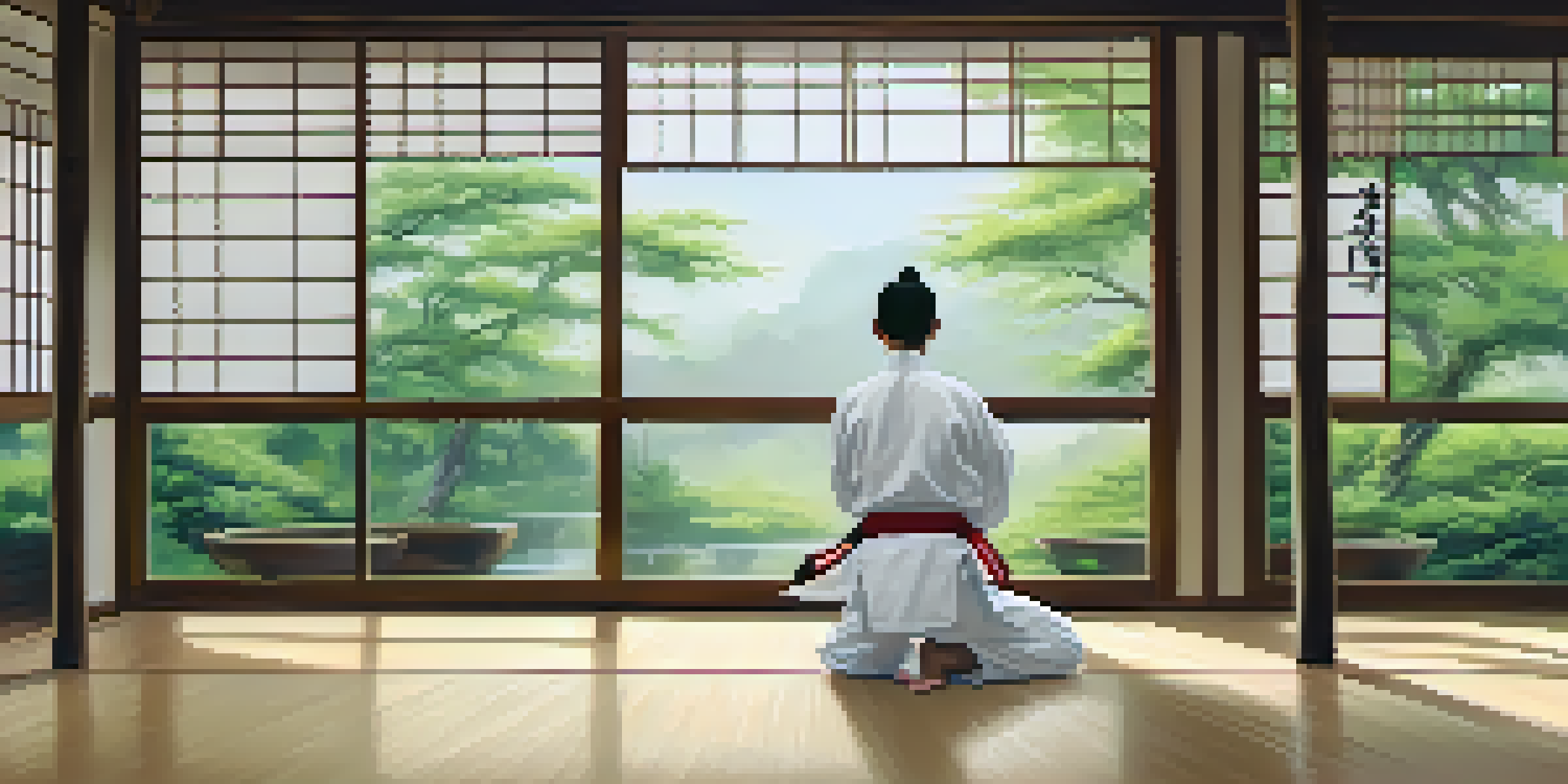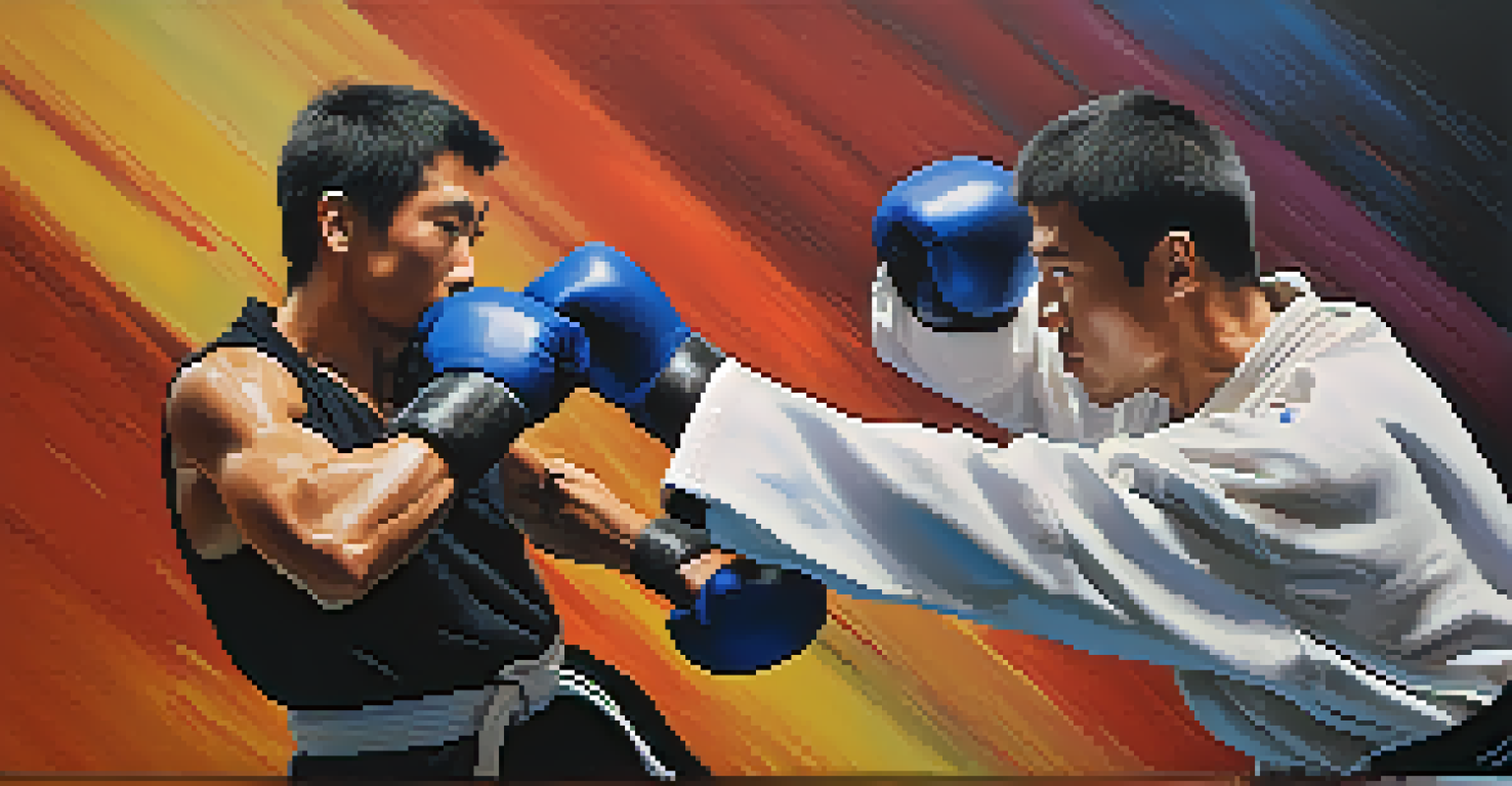Martial Arts Techniques for Effective Communication

Understanding the Basics of Martial Arts Communication
Martial arts is often perceived as a physical discipline, but it also emphasizes the importance of communication. Just as in martial arts, effective communication requires understanding your opponent, or in this case, your conversational partner. It’s about reading body language, tone, and context, which are critical in both sparring and dialogue.
The single biggest problem in communication is the illusion that it has taken place.
In martial arts, practitioners learn to observe and anticipate their opponent's moves. Similarly, in communication, being attentive allows you to respond more thoughtfully. This attentiveness can lead to deeper connections and more meaningful conversations, enhancing your overall interpersonal skills.
Ultimately, mastering the basics of communication in martial arts can empower you to express yourself clearly while also being receptive to others. It sets the stage for all the advanced techniques that follow, just as basic stances are foundational in martial arts.
The Importance of Active Listening in Martial Arts
Active listening is a martial arts principle that translates beautifully into effective communication. In martial arts, being able to listen to your opponent's movements can mean the difference between victory and defeat. When you apply this same principle to conversations, you become more aware of the nuances in what others are saying.

By focusing fully on the speaker, you demonstrate respect and openness, which encourages a more honest and engaging dialogue. This level of listening goes beyond just hearing words; it involves interpreting emotions and intentions, much like reading an opponent's stance before making your move.
Communication Requires Active Listening
Active listening in conversations mirrors the attentiveness needed in martial arts, enhancing understanding and engagement.
Incorporating active listening into your daily interactions can significantly enhance your relationships. Just as a martial artist refines their technique through practice, you can develop your listening skills to become a more effective communicator.
Non-Verbal Cues: The Silent Language of Martial Arts
Non-verbal communication is a vital aspect of both martial arts and everyday interactions. Just as a martial artist uses posture, gestures, and facial expressions to convey intention, we also communicate a great deal without saying a word. Understanding these non-verbal cues can help you navigate conversations with greater ease.
The most important thing in communication is hearing what isn't said.
For example, a confident stance in martial arts can assert dominance, while a relaxed posture can signal openness. Similarly, maintaining eye contact and using appropriate facial expressions can enhance your message and make you more relatable. This awareness not only helps in conveying your own feelings but also in interpreting those of others.
Practicing non-verbal communication can enrich your conversations and aid in building rapport. Like mastering a new technique in martial arts, it takes time and practice, but the rewards are well worth the effort.
The Role of Respect and Courtesy in Communication
Respect and courtesy are cornerstones of martial arts, and they play a significant role in effective communication as well. Just as martial artists bow to express respect before and after a match, showing respect in conversations sets a positive tone. It fosters an environment where ideas can flourish and where all participants feel valued.
When you approach conversations with respect, you create a safe space for open dialogue. This approach encourages others to share their thoughts and feelings without fear of judgment, leading to richer discussions. In martial arts, mutual respect can often lead to better sparring experiences, just as it can lead to more productive conversations.
Non-Verbal Cues Matter in Dialogue
Just like in martial arts, non-verbal communication—such as posture and eye contact—plays a crucial role in conveying intentions and emotions.
Incorporating respect and courtesy into your communication techniques can transform your interactions. This simple yet profound shift can enhance both personal and professional relationships, allowing for deeper understanding and collaboration.
Using Breathing Techniques to Calm Communication
In martial arts, controlled breathing is essential for maintaining focus and composure. Similarly, when emotions run high in conversations, taking a moment to breathe can help you respond thoughtfully rather than react impulsively. This technique can be particularly useful in conflict resolution, where tempers may flare.
By practicing deep breathing, you not only calm your own nerves but also create a more peaceful atmosphere for dialogue. It’s like resetting your stance before a sparring match — taking that moment can help you approach the conversation with clarity and purpose.
Integrating breathing techniques into your communication toolkit can lead to more productive discussions. Just as martial artists train their bodies to react effectively, you can train your mind to respond calmly under pressure.
The Art of Assertiveness: A Martial Arts Perspective
Assertiveness is a critical skill in both martial arts and communication. In martial arts, being assertive means confidently expressing your techniques and intentions without aggression. This principle applies to communication as well, where being clear and direct can help you articulate your thoughts effectively.
When you practice assertiveness, you respect both your own needs and those of others. This balance is key to healthy interactions, as it allows you to stand your ground while remaining open to alternative viewpoints. Much like a martial artist who adapts their strategy based on an opponent’s moves, an assertive communicator can navigate discussions with flexibility and strength.
Empathy Enhances Connection
Building empathy through martial arts principles fosters deeper understanding and compassion in everyday conversations.
Embracing assertiveness can transform how you convey your ideas and feelings. This martial arts technique encourages you to express yourself authentically while fostering mutual respect in conversations.
Building Empathy Through Martial Arts Principles
Empathy is a powerful component of effective communication, and martial arts training often cultivates this skill. When sparring or practicing techniques with a partner, you learn to understand their perspective and physicality. This experience translates into everyday conversations, where empathy allows you to connect more deeply with others.
By putting yourself in someone else's shoes, you can better appreciate their feelings and viewpoints. Much like gauging an opponent's strength or strategy, empathy helps you navigate conversations with a greater understanding of the other person's needs and emotions.

Building empathy through martial arts principles can enhance your communication skills significantly. It promotes a culture of understanding and compassion, essential for fostering meaningful relationships in all areas of life.
Practicing and Refining Your Communication Techniques
Just as martial artists dedicate time to practice their moves, honing your communication techniques requires consistent effort. Engage in conversations with the mindset of a student eager to learn, and you'll discover areas for improvement. This practice can involve role-playing scenarios or simply reflecting on past discussions to identify what worked and what didn’t.
Additionally, seeking feedback from others can provide valuable insights into your communication style. Much like a martial arts instructor guiding you through complex techniques, constructive criticism can help you refine your approach and build confidence.
Ultimately, the journey of improving your communication skills mirrors the path of a martial artist. With dedication and practice, you can master the art of communication, making it an effective tool in both your personal and professional life.